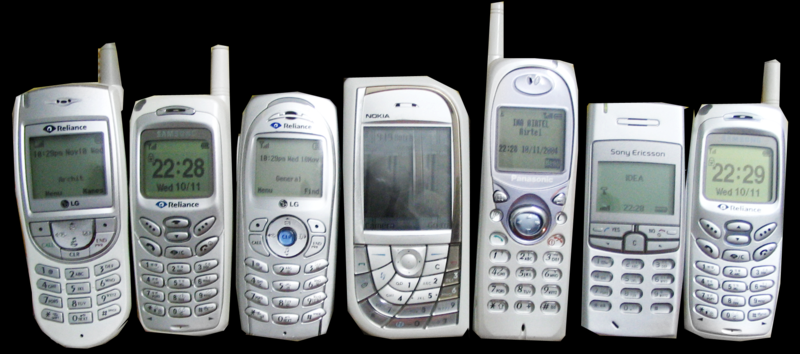
|
In 1908, US Patent 887.357 for a wireless telephone was issued in to Nathan B Stubblefield of Murray, Kentucky. He applied this patent to "cave radio" telephones and not directly to cellular telephony as the term is currently understood. Cells for mobile phone base stations were invented in 1947 by Bell Labs engineers at AT & T and further developed by Bell Labs during the 1960s. Radiophones have a long and varied history going back to Reginald Fessenden's invention and shore-to-ship demonstration of radio telephony, through the second world war with military use of radio telephony links and civil services in the 1950s, while hand-held cellular radio devices have been available since 1973. A patent for the first wireless phone as we know today was issued in US Patent 3.449.750 to George Sweigert of Euclid, Ohio on June 10, 1969. In 1945, the zero generation of mobile telephones was introduced. Like other technologies of the time, it involved a single, powerful base station covering a wide area, and each telephone would effectively monopolize a channel over that whole area while in use. The concepts of frequency reuse and handoff, as well as a number of other concepts that formed the basis of modern cell phone technology, are first described in US Patent 4.152.647, issued May 1, 1979 to Charles A. Gladden and Martin H. Parelman. This is the first embodiment of all the concepts that formed the basis of the next major step in mobile telephony, the Analog cellular telephone. Concepts covered in this patent (cited in at least 34 other patents) also were later extended to several satellite communication systems. Later updating of the cellular system to a digital system credits this patent. Martin Cooper, a Motorola researcher and executive is widely considered to be the inventor of the first practical mobile phone for hand-held use in a non-vehicle setting. Cooper is the inventor named on "Radio telephone system" filed in 1973 with the US Patent office and later issued as US Patent 3,906,166. Using a modern, if somewhat heavy portable handset, Cooper made the first call on a hand-held mobile phone on April 3, 1973 to a rival. The first commercial citywide cellular network was launched in Japan by NTT in 1979. Fully automatic cellular networks were first introduced in the early to mid 1980s. The Nordic mobile telephone (NMT) system went online in Denmark, Finland, Norway and Sweden in 1981. In 1983, Motorola was the first approved mobile phone by FCC in the United States. In 1984, Bell labs developed modern commercial cellular technology (based, to a large extent, on the Gladden, Parelman Patent), which employed multiple, centrally controlled base stations (cell sites), each providing service to a small area (a cell). The cell sites would be set up such that cells partially overlapped. In a cellular system, a signal between a base station (cell site) and a terminal (phone) only need be strong enough to reach between the two, so the same channel can be used simultaneously for separate conversations in different cells. Cellular systems required several leaps of technology, including handover, which allowed a conversation to continue as a mobile phone traveled from cell to cell. This system included variable transmission power in both the base stations and the telephones (controlled by the base stations), which allowed range and cell size to vary. As the system expanded and neared capacity, the ability to reduce transmission power allowed new cells to be added, resulting in more, smaller cells and thus more capacity. The evidence of this growth can still be seen in the many older, tall cell site towers with no antennae on the upper parts of their towers. These sites originally created large cells, and so had their antennae mounted atop high towers; the towers were designed so that as the system expanded—and cell sizes shrank—the antennae could be lowered on their original masts to reduce range. The first "modern" network technology on digital 2G cellular technology was launched by Radiolinia in 1991 in Finland on the GSM standard which also marked the introduction of competition in mobile telecoms when Radiolinja challenged incumbent Telecom Finland who ran a 1G NMT network. The first data services appeared on mobile phones starting with person-to-person SMS text messaging in Finland in 1993. First trial payments using a mobile phone to pay for a Coca Cola vending machine were set in Finland in 1998. The first commercial payments were mobile parking trialled in Sweden but first commercially launched in Norway in 1999. The first commercial payment system to mimic banks and credit cards was launched in the Philippines in 1999 simultaneously by mobile operators Globe and Smart. The first content sold to mobile phones was the ringing tone, first launched in 1998 in Finland. The first full internet service on mobile phones was i-Mode introduced by NTT DoCoMo in Japan in 1999. In 2001 the first commercial launch of 3G (Third Generation) was again in Japan.Until the early 1990s, following introduction of the Motorola MiscoTAC, most mobile phones were too large to be carried in a jacket pocket, so they were typically installed in vehicles as car phones. With the miniaturisation of digital components and the development of more sophisticated batteries, mobile phones have become smaller and lighter.
|
![]() Copyright(C) 2007
- 2020. All rights reserved.
Copyright(C) 2007
- 2020. All rights reserved.
